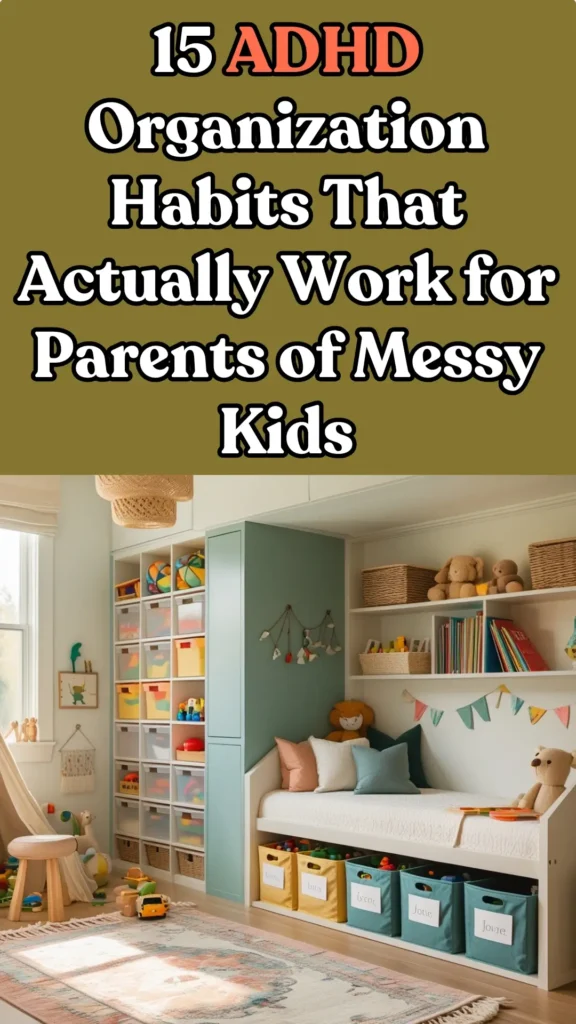Picture this: you walk into your child’s room and immediately feel that familiar wave of overwhelm.
Toys scattered everywhere. Missing homework buried under clothes. That mess that somehow multiplied overnight.
If this sounds like your daily reality, you’re absolutely not alone.
When your child has ADHD, even small messes can feel completely chaotic. Those typical organizing tips everyone swears by? They just don’t work for ADHD brains.
Your child needs structure that actually matches how their energetic, distractible mind works.
These 15 habits aren’t about creating picture-perfect rooms. They’re about building routines and systems that actually stick (even in the beautiful chaos of ADHD life).
And here’s the bonus: if you happen to have ADHD too, these will help you feel more in control instead of overwhelmed.
Don’t forget to save this pin for later so you can reference these tips whenever you need them!

Let’s dive in 💛
1. Give Every Item a “Home”
Label a bin or drawer with simple words like “blocks,” “art supplies,” or “books.”
Always put those items in the same spot. No exceptions.
This reduces the mental load for both of you and stops those “lost toy mysteries” from happening.
2. Use Visual Labels (Pictures + Words)
Your child’s brain loves visual cues.
Tape a photo of markers to the marker box. Add a picture of Legos to the Lego bin.
This combo of pictures and words helps them remember where things go and actually follow through.
3. Create Shortcut Task Lists (Tiny Steps They Can Actually Tackle)
“Clean your room” feels impossible to an ADHD brain.
Break it down like this:
- Pick up clothes
- Put books away
- Throw away trash
Micro-steps create micro-momentum. And momentum builds success.
4. Do a Daily 5-10 Minute Family Reset
Pick a time that works for your family (after dinner or before bedtime work great).
Set a timer and do a quick, shared cleanup together.
This consistent routine prevents that overwhelming mess buildup the next day.
5. Keep Open Bins at Kid-Level
If it’s easy to grab and put away, they’ll actually do it.
Keep storage bins low to the ground. Ditch the lids whenever possible.
Less friction equals more follow-through.
6. Zone Your Child’s Space
Create specific areas for different activities.
Art corner over here. Reading nook over there. Building space by the window.
When they finish an activity in one zone, the mess stays contained instead of spreading everywhere.
7. Color-Code for Instant Clarity
Assign colors to different categories: blue for art supplies, green for blocks, red for cars.
Visual cues eliminate those “Where does this go?” moments for both of you.
Your child’s brain will start making these connections automatically.
8. Rotate Toys Regularly
Put half the toys away and rotate them every 4-6 weeks.
This keeps things fresh and interesting while cutting down the amount of stuff out at any given time.
It’s like getting new toys without actually buying new toys.
9. Do a Weekly Quick Check-In
Spend just 10 minutes scanning their room each week.
Look for trash, missing toy parts, or random items that wandered in.
These tiny weekly resets prevent those monthly room disasters.
10. Fire Up the Movement + Clean-Up Combo
Play upbeat music or turn cleanup into a race.
ADHD brains thrive on movement and novelty. Boring tasks become fun challenges.
They’ll pick up faster when their energy has somewhere to go.
11. Create a “Launch Pad” by the Door
Set up a basket or hooks near your exit door.
This holds backpacks, important papers, coats, and everything they need to grab on the way out.
No more chaotic mornings searching for missing items.
12. Celebrate Every Small Win
Did they toss one item into the right bin? Acknowledge it!
“I love how you put that back where it belongs. Thank you!”
Even small recognition fuels lasting habits and builds their confidence.
13. Try the “Repeat Back” Trick
Give them an instruction, then ask them to repeat it back.
“Please put your shoes on the shelf.” They say it back to you.
This locks the message into their brain and reduces those “Mom, what did you say?” moments.
14. Simplify the Bedroom Environment
Keep their room calm and minimal: bed, one shelf, fewer distractions.
A peaceful space helps their brain focus better (especially important for sleep and rest).
Less visual chaos equals better mental clarity.
15. Teach Them to Declutter Thoughtfully
Sit with them every few months and ask gentle questions.
“Does this help us? Do we actually use it? Does it make you happy or stressed?”
Work together as a team to clear out items that no longer serve your family.
💙 Final Thoughts
These habits were designed for parents helping ADHD kids, but they work beautifully for any family dealing with mess-prone children.
If you also have ADHD, these systems won’t overwhelm you. Instead, you’ll find relief.
They meet your family’s brain exactly where it is: energetic, full, sometimes messy, and always loving.
You don’t have to be perfect. You just need systems that survive real daily life.
Try one habit this week. If it feels good, add another one.
Small wins build real relief over time.
You’ve got this. You’re doing so much better than you know.